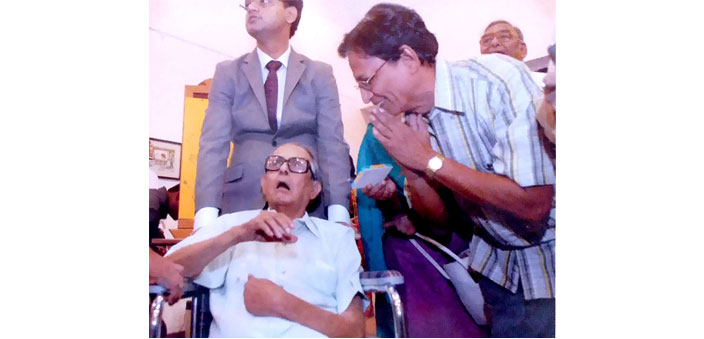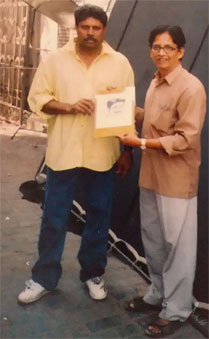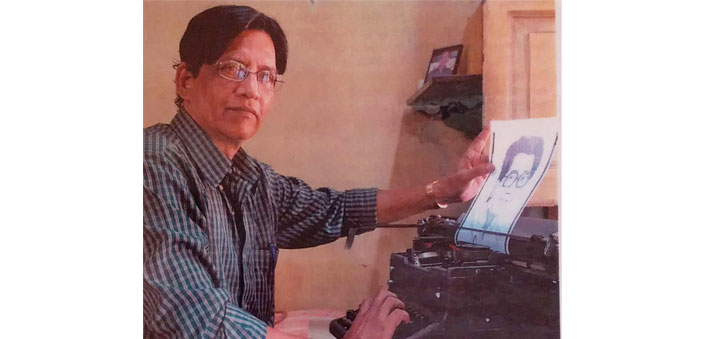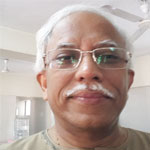Tell us about your career so far.
After S.S.C. in 1963, financial constraints deprived me of the opportunity to join the J.J. School of Art. Heeding my father’s advice, I learned stenography and typing and acquired typing speed of about 90 wpm (words per minute) with accuracy, in a year and a half. Joining the Esplanade Court as a typist in 1965, I then joined Bombay University and finally in 1967, joined Union Bank of India, from where I took voluntary retirement in 1996 after 30 years.
What is typewriter art? What other name would you give it?
Drawing pictures/portraits/designs on the manual typewriter using different keys is my forte. You can call it ‘Typography’. In Marathi, it is known as Tankachitra.
How did you get into this genre?
In 1967, after I joined the Union Bank, my boss once instructed me to type a list of intercom telephone numbers. Instead of typing them as a list, I typed them in the shape of a telephone instrument. This inspired me and made me realise that through this medium, I could develop this art and become an artist. I am not into any other genre of painting or art.

Who influenced you to take up this art seriously?
My father encouraged me saying, ‘Chandrakant, you wanted to join the J.J. school of Art, but couldn’t. Forget the past and get deep into this art form. You will be vindicated’.
Is there any typewriter artist you look up to?
No, I don’t know anybody following the art form in India, though possibly there might be many.
What typewriter do you use? What is your typing speed? Any history behind it?
I am using a Halda typewriter for the last 50 years. I don’t know my speed now, but in 1966 it was 90 wpm, with absolute accuracy, like Sunil Gavaskar’s batting! The life of the ribbon depends on the use of typewriter, but it lasts for a minimum two months.
Prior to taking VRS, I approached our administration department and requested them to let me purchase the typewriter at any price, as I had used it for so many years. But I was told it was government property. A day before my VRS, I met our Chairman and confided in him my sorrow.
As Chief Guest at my farewell function, he mentioned our conversation and said, “Chandrakant, we are allowing you to purchase this typewriter, but for that you have to pay rupee one”. I think that was the greatest gift I received in my life. Now that typewriter is like our family member.

I have done a few landscapes and greeting cards, as also Olympics signs, the Filmfare trophy, R.K. and Raj Kamal (V Shantaram’s) studio emblems, etc.
Where do you derive the patience to indulge in this art?
Where there is a will there is a way! Of course, you require a lot of patience and concentration when you are doing a picture on the typewriter. One wrong stroke and your picture is gone. There is no delete key available like in a computer.
How long does one painting take?
It takes about 4 to 5 hours, though not continuous, and with many breaks. It is very painstaking. For instance, Dilip Kumar’s picture took about six hours.
Do you do it black and white or also in colour? How many pieces have you done so far?
Usually the cotton ribbon is in black colour. Silk ribbon is in black and red. I have done some pictures/designs/greetings in black and red colour too. Till date, I must have done more than 150 pictures/portraits/designs/logos.
Does this art not affect your fingers and general health?
It’s very laborious as you have to keep turning the page all the time to hit the strokes. You have to be very careful. I use my left hand to hold the paper and right hand index finger to type. My hand starts aching after about 15 minutes. It is not possible to make a picture at a stretch. For shading a picture, I make a light or hard touch on the keys. For that purpose, with the left hand you have to hold the rod tightly. Once the picture is ready, you forget everything.
Doesn’t the sound of the typewriter trouble your family?
As far as I am concerned, I have been doing this for the past 50 years. No exaggeration, but I must have literally typed lakhs of pages on my typewriter and hence, I am used to this beautiful sound of typing. My family members have never complained about it.
Why have you not tried to draw on the computer?
There is no problem in doing pictures with the help of computers, but then it would not be a challenge and so, not much satisfaction. A computer can do anything. You can always delete if you make mistake and re-do with it, but you can’t do that with the manual typewriter. That’s what makes my work on the typewriter so interesting.
Have you got awards? Have you tried for Limca or Guinness records?
I have got more than 20 state level awards for this innovative art. I have not tried for Limca or Guinness records, however. In 1985, the Maharashtra Kamgar Kalyan Mandal, Government of Maharashtra, awarded me “Gunavant Kamgar” Kalyan Puraskar. This award was given to me for outstanding work in the field of banking and for excellence and efficiency in the performance of work and other social activities.
What has been the reaction from cartoonists and celebrities?
Celebrated cartoonists like R.K. Laxman, Mario Miranda, Vikas Sabnis, Suresh Sawant, Prabhakar Bhatlekar, Mangesh Tendulkar, former Mayor of Mumbai Nirmala Samant-Prabhavalkar, and celebrities like Sunil Gavaskar, Bharat Dabholkar, compere Sudhir Gadgil, Dr. Savita Ambedkar, writer Pu La Deshpande, V.P. Kale, Babasaheb Purandare, historian, Behram Contractor (Busy bee) have appreciated my art work, and some have even inaugurated my exhibitions.
Have you had solo exhibitions? What has been the response?
Till date, I have had 11 solo exhibitions, fourof them sponsored by the Union Bank. Seven were held in Mumbai (including one at IIT Mumbai’s ‘Mood Indigo’ festival). I received tremendous response at all the exhibitions.
What are your other hobbies?
I have drawn about 800 Spell-O-Fun on computer with different fonts. It is a CD prepared in the form of a slide show. On one page there are two words. Each page is displayed for seven seconds; then the next page appears again with two words. The 45 minutes CD has instrumental background music by my good friends, and favourite music directors Shankar-Jaikishan. I also have autographs of many famous personalities like actors, sports persons, etc.
I have also a collection of about 100 unique number currency notes e.g., 123456, 111111, 222222, 888888, 000001.1000000 and so on.
Have you been interviewed by the media?
Many newspapers and magazines have featured articles and interviews on me and my art. All India Radio, Mumbai, interviewed me after I received the “Gunavant Kamgar” Kalyan Puraskar in 1985, as alsoE-TV Marathi. Apart from other interviews, ABP Maza interviewed me live for about 16 minutes on the occasion of my 70th birthday on 2nd April, 2016.
Any other information you would like to share?
In the year 1993 on their Silver Jubilee, All India Bank Depositors’ Association headed by the late consumer activist M.R. Pai honoured me publicly for outstanding work done by me in compiling exhaustive circulars/instructions/guidelines issued by the Government of India from time to time. In 1995, the Chairman, Union Bank of India, awarded me Rs.11,000/- for outstanding work of compilation.
Godrej & Boyce Co. recognised my art by publishing an article about me in the book With Great Regards – The Story of Typewriter in India, edited by senior journalist Siddharth Bhatia. They have also included my interview in a short documentary film on the typewriter. Earlier, in 2010, the Union Bank recognised my work by including an article on me in the book titled Bankers Beacon – The story of Union Bank of India compiled by the late journalist M.V. Kamath.
Anyone in the family who has taken to your art?
No. Even my son is not interested as he is too busy with his job.


 [/column]
[/column]